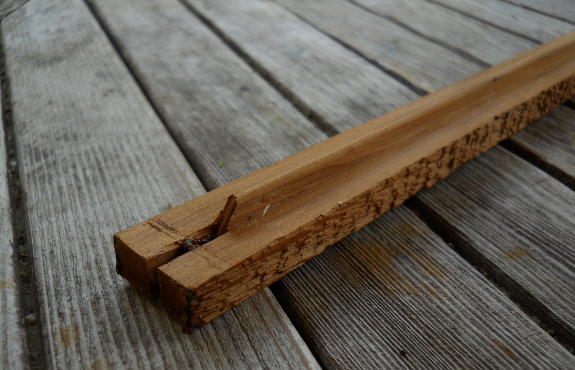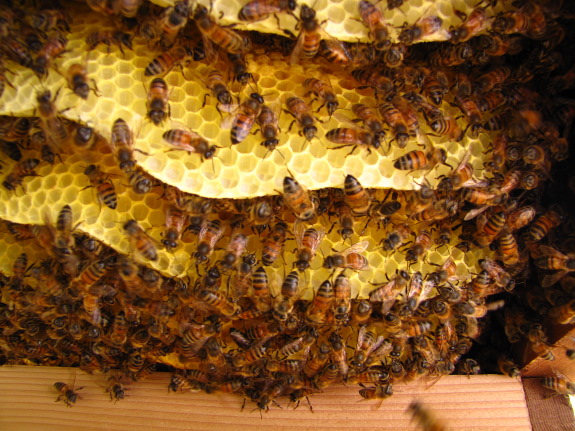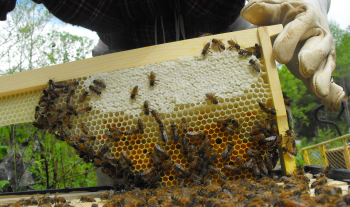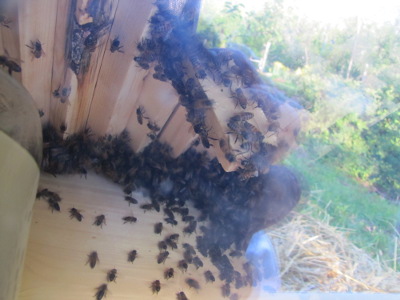
Types of top bars for bees

I haven't mentioned this
in a couple of years, so new readers might be interested in learning
about how foundationless frames
help deter varroa mites. The absence of
foundation can also help promote the health of your bees since
chemicals are often embedded in the beeswax that's used to make
foundation. The infrastructure to help bees build
regimented combs of honey without frames of foundation is generally
referred to as a top bar.
 Now that you know why you might choose top bars,
let's talk about the specific frame Mike was asking about. The
photo at the top of this post shows the top bars that came with our
premade Warre hive. You can get these for $1.50 apiece at
Beethinking (or at
least I think you can --- that's where ours came from in 2012, although
the picture on their website shows a different design). Even
though the top bar is only a tiny piece of wood, I think these are
worth buying if you can afford them since they're rather complex to
build yourself, and this design definitely helped our bees create
beautiful, straight comb with no foundation. We did modify
the box slightly to use pins instead of nails, though, in order to make
the frames easier to move.
Now that you know why you might choose top bars,
let's talk about the specific frame Mike was asking about. The
photo at the top of this post shows the top bars that came with our
premade Warre hive. You can get these for $1.50 apiece at
Beethinking (or at
least I think you can --- that's where ours came from in 2012, although
the picture on their website shows a different design). Even
though the top bar is only a tiny piece of wood, I think these are
worth buying if you can afford them since they're rather complex to
build yourself, and this design definitely helped our bees create
beautiful, straight comb with no foundation. We did modify
the box slightly to use pins instead of nails, though, in order to make
the frames easier to move.
 I've
seen (and used) various other top bar options, and one of these might
be better for you, depending on your situation. If you're using a
Langstroth hive, it's simplest to modify the frames that come
with the hive.
You can nail the wooden strip that's usually used to hold foundation on
vertically instead of horizontally, but I didn't have luck with getting
bees to build from that option. Instead, thin strips of
foundation at the top of each frame worked well for me. (Of
course, you still end up with a bit of foundation in the hive with this
method, but much less than if you filled the whole frame with
foundation.)
I've
seen (and used) various other top bar options, and one of these might
be better for you, depending on your situation. If you're using a
Langstroth hive, it's simplest to modify the frames that come
with the hive.
You can nail the wooden strip that's usually used to hold foundation on
vertically instead of horizontally, but I didn't have luck with getting
bees to build from that option. Instead, thin strips of
foundation at the top of each frame worked well for me. (Of
course, you still end up with a bit of foundation in the hive with this
method, but much less than if you filled the whole frame with
foundation.)
 This image, through a viewing
window up into a horizontal top-bar hive, shows the V-shaped top bars
that are perhaps the simplest to construct if you're making your
own. The
package we installed in our top bar hive absconded, so I can't tell you whether
our bees would have built off these top bars, but I believe most
top-bar beekeepers use a similar design with good results, so it's
worth a try.
This image, through a viewing
window up into a horizontal top-bar hive, shows the V-shaped top bars
that are perhaps the simplest to construct if you're making your
own. The
package we installed in our top bar hive absconded, so I can't tell you whether
our bees would have built off these top bars, but I believe most
top-bar beekeepers use a similar design with good results, so it's
worth a try.
No matter what kind of
top bar you use, the idea is pretty simple. You want to make the
bottom of the bar come to a point to tempt your bees to draw out comb
in a straight line. And you want to allow the right amount of
space between frames (if you're using a vertical hive like a Warre hive
or Langstroth hive) so that bees can pass through but won't be tempted
to fill in the gap. In contrast, with a horizontal top-bar hive,
you want to have the top bars completey fill the space so that bees
don't end up under the roof. Those two design points in place, a
top bar can be pretty much anything you dream up.
Want more in-depth information? Browse through our books.
Or explore more posts by date or by subject.
About us: Anna Hess and Mark Hamilton spent over a decade living self-sufficiently in the mountains of Virginia before moving north to start over from scratch in the foothills of Ohio. They've experimented with permaculture, no-till gardening, trailersteading, home-based microbusinesses and much more, writing about their adventures in both blogs and books.
Want to be notified when new comments are posted on this page? Click on the RSS button after you add a comment to subscribe to the comment feed, or simply check the box beside "email replies to me" while writing your comment.

Making top bars is nontrivial but not that hard to batch off with a tablesaw. If I may, here is the post from the bee blog my sweetie and I run, describing how we made the top bars for our second tanzanian hive.
http://theprospectofbees.wordpress.com/2013/02/21/making-top-bars/